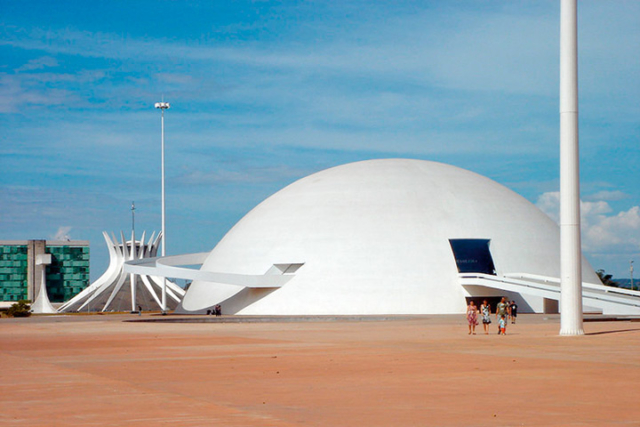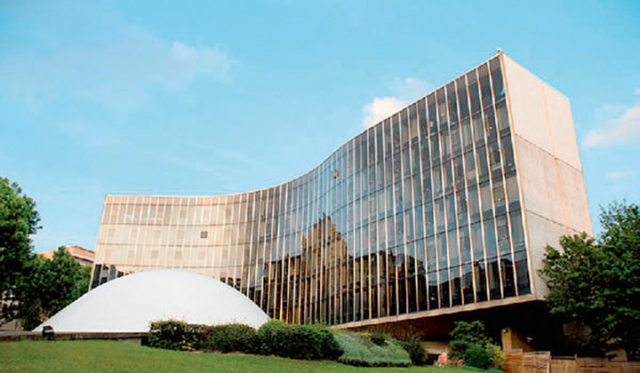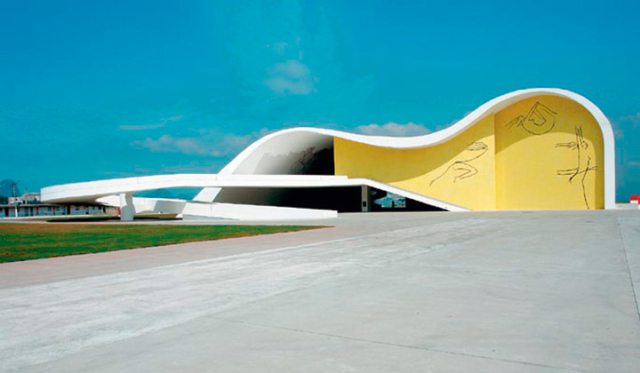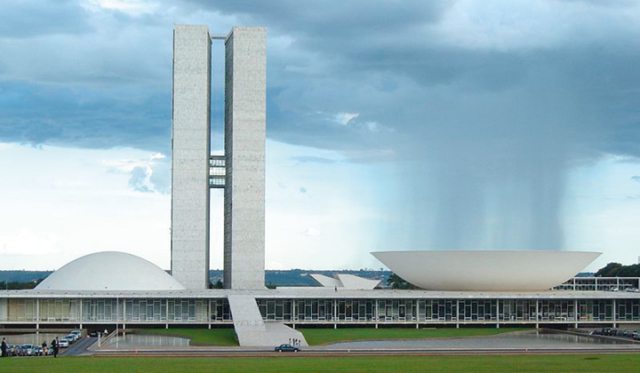Oscar Niemeyer proslavio je 103. rođendan 15. decembra 2010. godine i na taj dan otvorio je kupolu Međunarodnog kulturnog centra Oscara Niemeyera u Španiji, u Asturianskom gradu Aviles. Međutim, nije inaugurisao samo ovaj objekat, već i svoju Fondaciju u Rio de Janeirou, takođe, barem virtuelno jer još nije završena. Brazilski genije insistirao je na otvaranju i tog objekta istog dana. Možda je u njemu preovladao strah od smrti?
Pored 600 urađenih objekata širom sveta, Niemeyer i dalje radi. Trenutno radi na nacrtima za katedralu u gradu Belo Horizonte, muzej fudbala, koji će biti nazvan po Peleu, u Santosu, akvarijum u gradu Buzios i crkvu u Petropolisu, kao i više projektata van Brazila, u Alžiru i Argentini – u gradu Rosario.
Oscar Niemeyer svakog dana dolazi na posao u svoj arhitektonski studio na zadnjem spratu zdrade u Rio de Janeirou sa pogledom na obalu Copacabana. Gosti iz inostranstva bili su iznenađeni da je njegov studio i dalje “pušacka zona”. Oscar pali svoju cigaru i priča:
“Moju arhitekturu delim na pet različitih perioda: prvi je Pampulha, zatim period od projekta Panpulha do Brazilije, posle toga sledi period Brazilije, na koji se nastavlja moj prekookeanski rad, i na kraju, ali ne i poslednji je rad na mojim skorašnjim projektima. Nikada nisam komentarisao uticaj događaja u svetu arhitekture na ove periode ili na način na koji razmišljam kao arhitekta. Danas, gledajući unazad na svoj rad, bolje razumem zašto on, kroz svih pet faza, neosporno sadrži element pobune.”
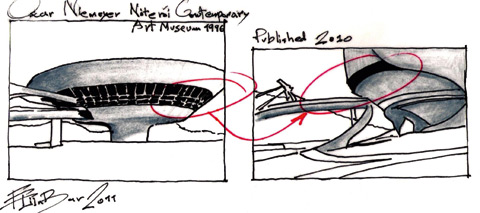 Kada je 1988. godine zakasnelo nagrađen Pritzkerovom nagradom za arhitekturu Oscar Niemeyer je imao 81 godinu, i mnogi su smatrali kao nepravdu da se ovom velikanu arhitekture nagrada dodeljuje tek na kraju karijere. Malo ko je mogao da pretpostavi da će Oscar Niemeyer još 23 godine biti intenzivno aktivan i da sada u 2011. završava dva velika projekta: trg u Kazakstanu i umetnički centar u Asturijasu, Španija, kao i nekoliko objekata u Brazilu.
Kada je 1988. godine zakasnelo nagrađen Pritzkerovom nagradom za arhitekturu Oscar Niemeyer je imao 81 godinu, i mnogi su smatrali kao nepravdu da se ovom velikanu arhitekture nagrada dodeljuje tek na kraju karijere. Malo ko je mogao da pretpostavi da će Oscar Niemeyer još 23 godine biti intenzivno aktivan i da sada u 2011. završava dva velika projekta: trg u Kazakstanu i umetnički centar u Asturijasu, Španija, kao i nekoliko objekata u Brazilu.
Kao ubeđeni komunista i ateista Niemeyer je projektovao Sedište komunističke partije u Parizu ali i katoličku katedralu u Brazilu i džamiju u Alžiru. On je bio i ostao privržen komunističkim idejama ali smatra da arhitektura ne treba da bude ideološki obojena. Arhitektura po njemu treba da afirmiše univerzalni estetski kvalitet. Slično je govorio i Mies van der Rohe kritikujući svoje kolege koje su na Bauhausu zastupale ideju o socijalnoj uslovljenosti arhitekture. Radi boljeg razumevanja Niemeyerovog dela zanimljivo je uporediti ove dve legende savremene arhitekture. Oni su do savršene jednostavnosti razvili svoj arhitektonski stil. Na prvi pogled to su dva potpuno suprotna koncepta. Mies sintetizuje pravougaone geometriske forme u jednostavne arhitektonske oblike težeći savršestvu koje dostiže Maljević na svojoj slici “Beli kvadrat na belom”. Znajući da je Mies bio pripadnink Bauhausa i na taj način učesnik Evropskog pokreta moderne umetnosti ne čudi bliskost sa ruskim konstruktivistima i supermatizmom Kazimira Maljevića. Na drugoj strani sveta, daleko od evropskih uticaja, Niemeyer, u Brazilu gde je rođen i školovan, povezuje stari i novi svet svojom autentičnom arhitekturom reinterpretirajući ideje Bauhausa i Evropske moderne. Beli kvadrat na belom, Kazimira Maljevića pod blještavim brazilskim nebom transformise se u beli krug na belom kao simbolički znak Niemeyerove arhitekture. Mies i Niemeyer živeli su u paralelnim svetovima, na velokoj udaljenosti jedan od drugog i nikada se nisu sreli. Oscar je bio komunista dok je Mies na levičarskom Bauhausu bio jedini desničar. Mies pravim linijama definiše prostor, isti prostor koji Oscar oblikuje krugovima. Uz sve razlike koje smo nabrojali njih povezuje duh vremena i zajednička ideja da kroz arhitekturu dostignu savršenstvo prirodnih oblika – arhitektura je novostvorena priroda, kao i zajedničko supermatističko ishodište – belo na belom. Oni nisu imitirali prirodu već su otkrivali stvaralačku snagu prirode. Njihove zgrade doživljavamo kao prirodnu pojavu, kao kada gledamo planinu ili reku i kažemo: to je to što nam priroda daruje.
Wassili Kandinsky je imao isti cilj da na svojim slikama da stvara autonomnu (izmišljenu) prirodu. On je govorio da ga dok slika pokreće unutrašnja nužnost. Da bi osetili tu energiju prenesenu u materiju, ove slike i zgrade morate videti uživo.
 Zgrade Oscara Niemeyera poseduju jednu sakralnu dimenziju ali nisu posvećene bogovima nego su namenjene ljudima da se osete ponosnim, da povrate veru u smisao života. One su namenjene u slavu i zahvalnost životu. Kada sam pre dve godine posetio zgradu gde je Sedište komunističke partije u Parizu osetio sam tu svečanu dimenziju već na ulasku u zgradu. Kako Niemeyer postiže ovaj utisak zračenja? Utisak ritualnog ulaska u hram. Nasuprot dugoj klasicističkoj tradiciji obeležavanja značajnih objekata, ovde nema raskošne pozlaćene ikonografije, kitnjastih oblika ni skupocenih materijala. Tu je dominantna sama ideja izlivena u betonu. Oseća se kreativna energija koja zrači. Sada mala komunistička partija francuske koristi ovo remek delo arhitekture koje je ujedno i spomenik prošlog vremena. Oni ljubazno dočekuju posetioce iz celog sveta koji dolaze ovde kao u muzej arhitekture. Oscar Niemyer nije nikada osećao potrebu da objašnjava svoje delo. On radije govori o svojim osećanjima:
Zgrade Oscara Niemeyera poseduju jednu sakralnu dimenziju ali nisu posvećene bogovima nego su namenjene ljudima da se osete ponosnim, da povrate veru u smisao života. One su namenjene u slavu i zahvalnost životu. Kada sam pre dve godine posetio zgradu gde je Sedište komunističke partije u Parizu osetio sam tu svečanu dimenziju već na ulasku u zgradu. Kako Niemeyer postiže ovaj utisak zračenja? Utisak ritualnog ulaska u hram. Nasuprot dugoj klasicističkoj tradiciji obeležavanja značajnih objekata, ovde nema raskošne pozlaćene ikonografije, kitnjastih oblika ni skupocenih materijala. Tu je dominantna sama ideja izlivena u betonu. Oseća se kreativna energija koja zrači. Sada mala komunistička partija francuske koristi ovo remek delo arhitekture koje je ujedno i spomenik prošlog vremena. Oni ljubazno dočekuju posetioce iz celog sveta koji dolaze ovde kao u muzej arhitekture. Oscar Niemyer nije nikada osećao potrebu da objašnjava svoje delo. On radije govori o svojim osećanjima:
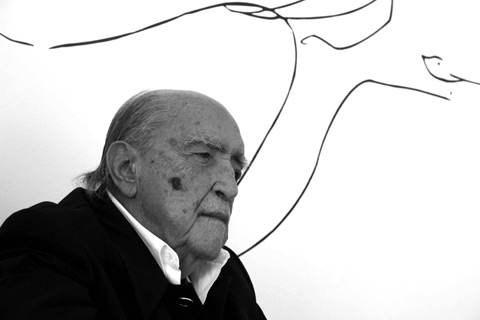 “Ono što me privlači jeste sledeće, neprekidna senzualna kriva linija. Kriva koju nalazim u planinskim predelima moje zemlje, na telu omiljene žene, oblacima na nebu i morskim talasima. Čitav univerzum sačinjen je od krivih – Ajnštajnov zakrivljeni univerzum.”
“Ono što me privlači jeste sledeće, neprekidna senzualna kriva linija. Kriva koju nalazim u planinskim predelima moje zemlje, na telu omiljene žene, oblacima na nebu i morskim talasima. Čitav univerzum sačinjen je od krivih – Ajnštajnov zakrivljeni univerzum.”
“U našem poslu, uvek težimo da iznenadimo. Upravo zbog toga ideja Bauhausa da arhitektura mora biti samo funkcionalna predstavlja apsolutnu besmislicu. Arhitektura može biti i praktična i lepa, može da zadivi. Naši objekti teže da zadovolje potrebne standarde, ali ljudi žele i nešto malo inventivnije, nešto sto će prevazići njihova očekivanja. Cilj je da se arhitektura pretvori u umetničko delo čija je glavna odlika generisanje emocije i osećaja zadivljenosti. Upravo to mi daje najveće zadovoljstvo. Mi tragamo za arhitekturom koja je lakša i slobodnija sa manje podupiranja, tako da postaje više smela i formira plemenit prostor gde ljudi mogu da se ponašaju na jedan nov način.”
“Arhitektura je moj posao i ja sam proveo čitav život uz crtaću tablu, ali život je važniji od arhitekture. Ono što je važno jeste unaprediti čovečanstvo.”
On 15th December 2010, Oscar Niemeyer celebrated his 103th birthday and on this particular day opened in Spain the cupola of the Oscar Niemeyer International Cultural Centre in the Asturian city of Aviles. But not only was this building inaugurated, his own Foundation in Rio de Janeiro as well… at least virtually, because it’s not completed yet. But the Brazilian genius insisted on opening it anyway on that day. The fear to pass away too early?
With 600 buildings around the world, Niemeyer doesn’t stop working. He is currently designing plans for a cathedral in Belo Horizonte, a football museum, which will be named after Pele, in Santos, an aquarium in Buzios, and a church in Petropolis and more projects outside Brazil in Algiers and Rosario in Argentina.
Every day Oscar Niemeyer goes to work in his studio located on the top floor of the building in Rio de Janeiro with the view on Copacabana beach. Visitors from abroad were surprised that his studio still is a “smoking zone”. Oscar lights up his cigar and talks about his architecture:
“I divide my architecture up into five different periods; first Pampulha, then from Panpulha to Brasilia, after that Brasilia, followed by my work overseas, and, last but not least, my most recent plans. I have never commented on the influence of events in the world of architecture on these periods or on my thinking as an architect. Today, looking back at my work, I have a better understanding of why, in all five phases, it undeniably contains an element of rebellion”.
When, in 1988, Oscar Niemeyer received his overdue Pritzker Architecture Prize he was 81 years old and many felt that awarding this great architect only at the end of his career was an injustice. Few could have guessed that Oscar Niemeyer will be intensely active another 23 years and that now, in 2011, he is about to complete two major projects – Square in Kazakhstan and Arts centre in Asturias, Spain, as well as several structures in Brazil.
As a convinced communist and atheist Niemeyer has designed the Communist Party Headquarters in Paris but also the Catholic Cathedral in Brazil and the Mosque of Algiers. He was and remains committed to communist ideas, but he also believes that architecture should not be ideologically colored. According to him architecture should affirm a universal aesthetic quality. Mies van der Rohe spoke in the similar way, criticizing some of his colleagues who represented ideas of social interdependence of architecture at the Bauhaus. For better understanding of Niemeyer’s work it is interesting to compare these two legends of contemporary architecture. They have developed their architectural styles to the perfect simplicity. At first glance, these are two totally opposite concepts. Mies synthesizes rectangular geometric forms to simple architectural forms, striving to reach perfection of Malevich’s painting “White Square on White”. Knowing that Mies was a member of Bauhaus and thus a participant of European Modern Art movement his propinquity with Russian Constructivists and Kasimir Malevich’s Suprematism is not surprising. On the other side of the world, far away from European influence, in Brazil where he was born and educated, Niemeyer created a link between the old and new world through his authentic architecture, by reinterpreting the idea of the Bauhaus and European modernism. Kasimir Malevich’s “White Square on White” under the bright Brazilian sky transforms into “White Circle on White” as a symbol of Niemeyer’s architecture. Mies and Niemeyer were living in parallel worlds, far away from each other and they have never met. Oscar was a communist while Mies was only a right-winger at the left oriented Bauhaus. Mies defines space with straight lines while Oscar shapes the same space with circles. With all the differences that we have listed, they are connected trough the spirit of time and a common idea of achieving perfection of natural forms trough architecture i.e. architecture as a newly created nature, and common suprematistic outcome – white on white. They were not imitating nature, they were revealing creative power of nature. We experience their buildings as natural phenomena, as if we were looking at the mountains or the river saying ‘this is what nature gives us’.
Wassili Kandinsky had the same goal to create an autonomous (fictional) nature in his paintings. He used to say that he is triggered by inner necessity. To feel the energy transferred into the matter, these paintings and buildings you must see personally.
Oskar Niemeyer’s buildings have one sacred dimension, but they are not dedicated to the gods. They are dedicated to people so that they can be proud and regain faith in the meaning of life. They were built in the glory and gratitude to life. Two years ago, during my visit to the building of Communist Party Headquarters in Paris, I felt that solemn dimension upon entering the building. How does the Niemeyer achieve this effect of emanation? The impression of ritually entering the temple. In contrast to the long classicist tradition of marking important structures, there is no lavish gilded iconography, or fancy shapes or expensive materials. There is a dominant idea itself cast in concrete. You can feel creative energy that radiates. At present a small French Communist Party uses this masterpiece of architecture which is, at the same time, a monument to the past times. They kindly welcome visitors from around the world who come here as if it were a museum of architecture. Oscar Niemyer never felt the need to explain his work. He prefers to talk about his feelings:
“What attracts me is the flowing, sensual curve. The curve which I find in the mountains of my country, in the body of a favourite woman, the clouds in the sky and the waves on the sea. The whole universe is made of curves – Einstein’s curved universe”.
“In our work, we are always looking to surprise. Because that Bauhaus idea that architecture has to be purely functional was absolute nonsense. Architecture can be both practical and beautiful. It can amaze. Our buildings set out to meet the required specifications, but people also want something a little inventive, that will confound their expectations. The aim is to turn architecture into a work of art, the main features of which are generating emotion and astonishment. That’s what gives me the greatest pleasure. We’re seeking an architecture that’s lighter and freer, with few supports, so that it becomes more daring and creates a more generous space, where people can behave in a new way”.
“Architecture is my work, and I’ve spent my whole life at a drawing board, but life is more important than architecture. What matters is to improve human beings”.





